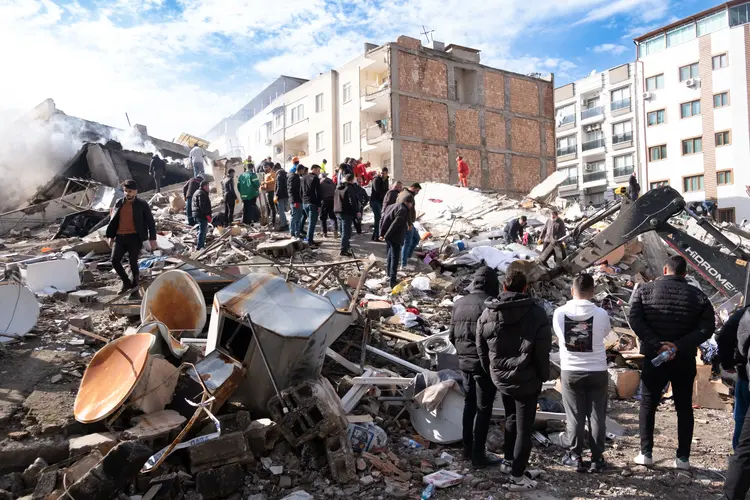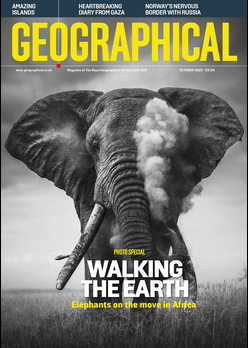
There are major technology lessons to be learned from the Türkiye-Syria quake, Doug Specht explains
In the early hours of 6 February 2023, a 7.2-magnitude quake struck central and south-eastern Türkiye and Syria. Nearly 60,000 people were killed, and 1.5 million were left homeless. The quake and its aftershocks came as a surprise, despite Türkiye employing Google’s earthquake alert system, designed to give millions of people precious seconds of warning. Google have now admitted that almost no one in Türkiye received that potentially life-saving message.
The failure was not merely technical; it is a stark demonstration of the profound risks hidden beneath our growing dependence on digital technology firms for disaster preparedness and response.
Enjoying this article? Check out our related reads:
A BBC investigation into Google’s involvement in the Turkish earthquake lays bare both strengths and weaknesses in the age of digital disaster management. In theory, Google’s early warning service harnesses the sensors in thousands of phones to detect seismic waves, sending alerts to mobile phones when these are predicted to develop into a life-threatening earthquake seconds before the shaking starts. Yet, only a few hundred people were notified, with Google’s predictive system massively underestimating the power of the incoming seismic waves.
The aftermath was chaotic. As buildings collapsed, people struggled to receive information. Digital communication tools faltered as mobile networks buckled under immense strain. The promises of technology, speed, scale, and coordination were quickly undermined by the reality that when infrastructure is weakest, dependence on technology is most dangerous. The earthquake served as a warning that algorithms, no matter how sophisticated, cannot replace robust, resilient public systems and analogue warnings.
The double-edged sword of big tech in disasters
Türkiye’s experience is not unique. Around the globe, digital platforms and increasingly artificial intelligence are remaking the way societies prepare for and respond to disasters. Satellite imagery, sensor networks, and real-time mapping provide vital data for rescuers and officials. Social media spreads warnings, connects the stranded, and mobilises volunteers with unprecedented speed. Powered by the giants of Silicon Valley, these technologies have undoubtedly saved lives.
However, the pitfalls are becoming just as apparent as the benefits. Overreliance on automated systems that are only as good as the data and infrastructure supporting them can end in tragedy. As in Türkiye, when warnings fail to reach those in harm’s way, digital dependence reveals itself as a vulnerability, not a strength.
One of the most significant risks of relying on large technology companies during disasters is the potential for system outages or signal loss. Natural catastrophes often strike with devastating force, damaging the very infrastructure, such as power lines, mobile towers, and internet cables, on which digital warning systems are built. When hurricanes flatten communications networks or earthquakes cut electricity, even the most advanced digital alert systems can fall silent. In such scenarios, critical warnings, evacuation instructions, and offers of help may not reach those in need.
Another hazard is the presence of algorithmic blind spots. Many emergency systems managed by tech firms rely on artificial intelligence and data-driven models to determine who receives warnings, where resources are dispatched, or which neighbourhoods are flagged as high-risk. While these systems can enhance efficiency, they often lack deep local understanding and context.

Algorithms might overlook crucial street-level details, cultural practices, or the unique vulnerabilities of certain communities. As a result, some groups, especially those who might be less digitally connected, such as the elderly, children, or residents in informal settlements, can be left out of evacuation plans or fail to receive timely information. In the Turkish earthquake, for example, digital alert systems were rarely updated with local data and failed to prioritise those most at risk.
Digital inequality is an equally profound concern, as the benefits of technological solutions in disasters seldom reach everyone equally. Sophisticated apps, real-time social media updates, and geolocation-based alerts predominantly serve those with up-to-date smartphones, reliable internet access, and a high level of digital literacy. Wealthier and urban populations thus enjoy layers of protection unavailable to people in rural, remote, or economically disadvantaged locations.
In communities without sufficient infrastructure or for those unable to afford cutting-edge devices, alerts may not arrive at all. This digital divide risks entrenching and even widening pre-existing social inequalities in life-and-death moments.
Finally, the immense scale of data collected by large technology firms during disasters raises difficult questions around privacy and oversight. To provide accurate alerts and coordinate responses, companies often gather vast troves of movement data, location tracking, and sometimes personal communications from affected populations. While the intention may be to save lives, the lack of transparency and clear regulation means sensitive data can be mishandled, retained longer than necessary, or potentially misused for commercial or surveillance purposes.

Public trust can swiftly erode if people feel that their personal information might be used against them or shared without consent. This concern is heightened in situations where emergency systems are designed and operated by private, often unaccountable, corporations rather than public authorities subject to democratic scrutiny.
This private model also creates a major accountability issue at the heart of digital disaster tech.. Companies like Google or Meta can shape public safety in crisis situations, yet their tools often operate as ‘black boxes’. Decisions about when, how, and whom to alert are determined by proprietary algorithms, tested far from the communities they serve. In Türkiye, the shortcomings of this approach had fatal consequences. There was no public accountability or clear mechanism to investigate and address system failures in the midst of catastrophe.
Hybrid solutions and human oversight
The Turkish earthquake should be seen not as an argument to reject technology in disaster response, but as a call to recalibrate our approach. Effective emergency preparedness must blend the best of digital innovation with tried-and-tested analogue systems. Sirens, radio broadcasts, community leaders, and public drills remain irreplaceable, especially where infrastructure is vulnerable.
For digital solutions, public accountability is crucial. Open standards for alert systems, local partnerships in technology rollouts, and independent oversight boards can help ensure these tools meet the needs of all communities, not just the technically privileged. Governments should require companies to share data transparently, support multilingual functionality, and ensure no group is left out of emergency communications.
Critically, disaster response planning must anticipate the failure modes of technology: from power outages and cyberattacks to algorithmic mistakes. Building in redundancy, so that an alert reaches people multiple ways, not just through a single app or device, could be the difference between life and death in the moments that matter. As societies confront mounting threats from climate change, urbanisation, and geopolitical tension, the path ahead must be one of resilience, diversity and humility—recognising tech’s strengths while never losing sight of its limits.




